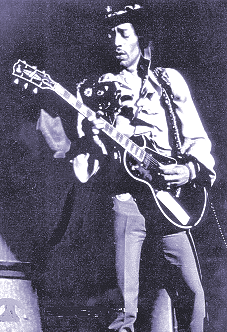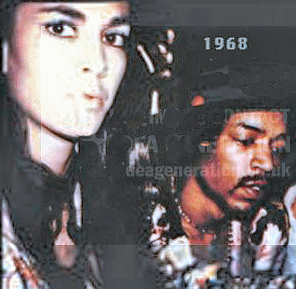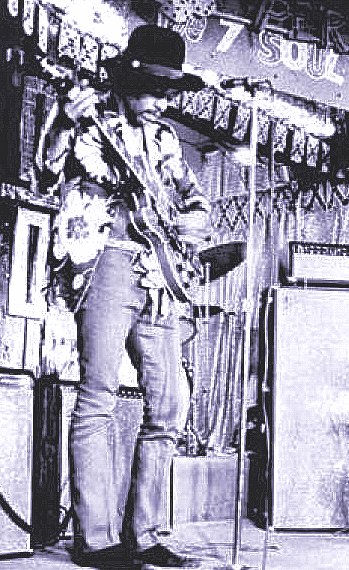VOODOO CHILE BLUES (by Jimi Hendrix). These outtakes of Jimi's autobiographical epic were recorded at the Record Plant around 7 am on May 2, 1968 with Steve Winwood (organ), Jack Casady (bass), and Mitch Mitchell (drums). A demo tape of Jimi alone, quietly sketching
Catfish Blues riffs, captures what appears to be a spontaneous evolution of
Voodoo Chile out of re-arranged fragments of
Catfish Blues. "I think really what it was," explained Track Records co-founder Chris Stamp, "was Jimi was making these extraordinary futuristic guitar sounds, but also you could hear almost the whole history of the blues in it, or something. There was a connection between the blues history of the guitar and the way that Jimi was taking it into the future."
MANNISH BOY (by McKinley Morganfield-Mel London-Ellas McDaniel). While on a record-breaking North American tour, Hendrix arrived at the Record Plant on April 22, 1969 and cut take after take of
Mannish Boy. Bo Diddley's 1955 hit,
I'm A Man, inspired Muddy Waters to echo that same year with
Mannish Boy. Jimi created a lyric hybrid of these two songs, but kept the maracas effect heard on the Diddley original. He also threw in a progression derived from the
Spencer Davis Group's '67 hit,
I'm A Man, by Steve Winwood & J. Miller. The
SDG hit later become a staple for
Chicago Transit Authority, who were the support group for the
JHE during the week that Jimi cut
Manish Boy. Ironically,
CTA's I'm A Man contains wah-wah guitar strumming inspired by Hendrix, thus bringing full circle Jimi's chain of
Mannish influences.
ONCE I HAD A WOMAN (by Jimi Hendrix). Recorded at the Record Plant on Jan. 23, 1970 with
A Band Of Gypsys (Buddy Miles, drums / Billy Cox, bass).
Once I Had A Woman, one of the slowest known Hendrix blues, builds to B.B. King-plays-the-buzzsaw distortion. In
Deep Blues, Robert Palmer noted an "African fondness for muddying perfectly clean sounds. African musicians will attach pieces of tin sheeting to the heads of drums or the necks of stringed instruments in order to get a noisy, rattling buzz...This preference for...impure sounds has always been evident in black American music. Some early examples of distorted blues guitar on record are:
Good Road Blues and
Alley Blues (Wright Holmes 1947),
Rocket 88 (Jackie Brenston 1950),
When I'm Gone (Joe Hill Lewis 1952),
Hart's Bread Boogie (Billy Love 1954),
Cotton Crop Blues (James Cotton 1954), and
She's Taking All My Money (Joe Hill Lewis 1956).
BLEEDING HEART (traditional, arranged by Jimi Hendrix). Recorded at the Record Plant on March 18, 1969. Personnal is unknown. The tape box lists Jack Adams as the engineer. "My main thing is the blues," Jimi once said, "people like Elmore James and a few others, B.B. King and so forth." He also cited Elmore James as among his favorite singers. But it was the nitty gritty wailing of Elmore's soaring slide guitar, recordings like
Hand In Hand (1953), which Jimi later simulated with amplified signal sustain, and without use of a slide.
JELLY 292 (by Jimi Hendrix). Recorded between 7:15 and 7:45 am on May 14, 1969 at the Record Plant. Bob Hughes was engineer, but the ensemble personnel remains a mystery. This cut is the first of several takes, a later one of which appeared as
Jam 292 on the
Loose Ends album (1974). "Guitar is the basic thing for me," noted Jimi, "voice is just another way of getting across what I'm doing musically." His
292 guitar "vocalizations" are more pronounced than Albert Collin's talking frets on cuts like
Conversation With Collins (1969). But the main boogie romp of
Jelly 292 is rooted in blues like
Dooji Wooji by Duke Ellington (1939),
Stomp Boogie by Earl Hooker (1953),
Have You Ever Been In Love? by Sonny Boy Williamson (1956), and
Jimmy's House Party by Jimmy Breslin (1956). The
292 riff is also interpreted by Junior Parker in
Sweet Home Chicago (1971) and
Hey Pretty Baby by Joe Hughs (1986).
TTG Studios - Oct. 1968
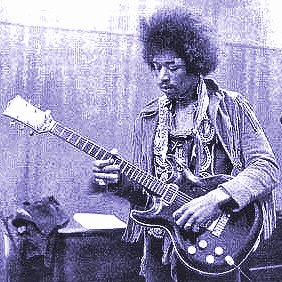
(by Jimi Hendrix). Recorded at L.A.'s TTG Studios on Oct. 29, 1968. "Angel" was the engineer. "I dropped by TTG Studios to watch Jimi at work," journalist Sharon Lawrence later wrote. "He was dejected by what he heard, obviously annoyed with himself. He put on his jacket and prepared to leave. Abruptly, he took it off again and purposefully strode into the main recording room. He picked up a guitar and started one of his classic blues numbers -
'There's a Red House over yonder...'" Jimi's rap intro over an extended trill is a standard blues technique used by players like John Lee Hooker (
Real Real Gone 1953,
Tupelo 1960,
Country Boy 1965) and Albert Collins (
Collins' Shuffle 1958). For this TTG track, Jimi is tuned one whole-step below concert pitch, playing at the B position, but sounding in A. He forms a final resolving cadence that the rest of the band fails to follow, until he catches their attention with one last feedback screech. "It was a long song," noted Lawrence, "he played and sang with so much feeling that the engineer could barely speak: 'Man, that was magnificent.' Jimi smiled, his eyes as well as his lips. His performance was a form of apology. 'Sorry I put you through all that caterwauling before...'."
Berkeley - May 1970
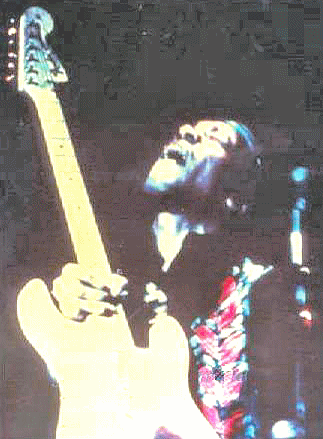
HEAR MY TRAIN A COMIN' (by Jimi Hendrix). Recorded live on May 30, 1970 at the Berkeley Community Theater with Billy Cox (bass) and Mitch Mitchell (drums). Originally released on the 1971 Rainbow Bridge LP, this track is widely considered to be the most perfectly formed and satisfying of all Hendrix blues performances. Hear My Train A Comin' follows an ugly-ducking-to-peacock transformation familiar from Jimi's Voodoo Chile cycle, but with different symbols. Hendrix recognized this "transformation" connection between the two songs and commented about it on stage; "Here's a story that a lot of us have been through...About a cat runnin' around town and his old lady, she don't want him around and a whole lot of people from across the tracks are puttin' him down. And nobody don't want to face up to it but the cat has somethin', only everybody's against him because the cat might be a little bit different. So he goes on the road to be a Voodoo Child, come back to be a Magic Boy." Whether Jimi travelled to a Crossroads, or simply past the outskirts of infinity, somewhere along the line a supernatural transfer inhabited his blues. As Tony Glover noted for Rolling Stone, "His demons are more electric and schizophrenic than those of Robert Johnson, the great Delta bluesman who in many ways can be considered Hendrix's spiritual father...Hendrix plays Delta blues for sure - only the Delta may have been on Mars."
Jimi's part-Cherokee/Irish grandmother, Nora Rose Moore, lived for one hundred years. She claimed to have seen everything in her lifetime. "I've seen slavery and I've seen Jimi Hendrix perform," said Nora Rose, "that about covers it."
Copyright © 1994 - Michael J. Fairchild






